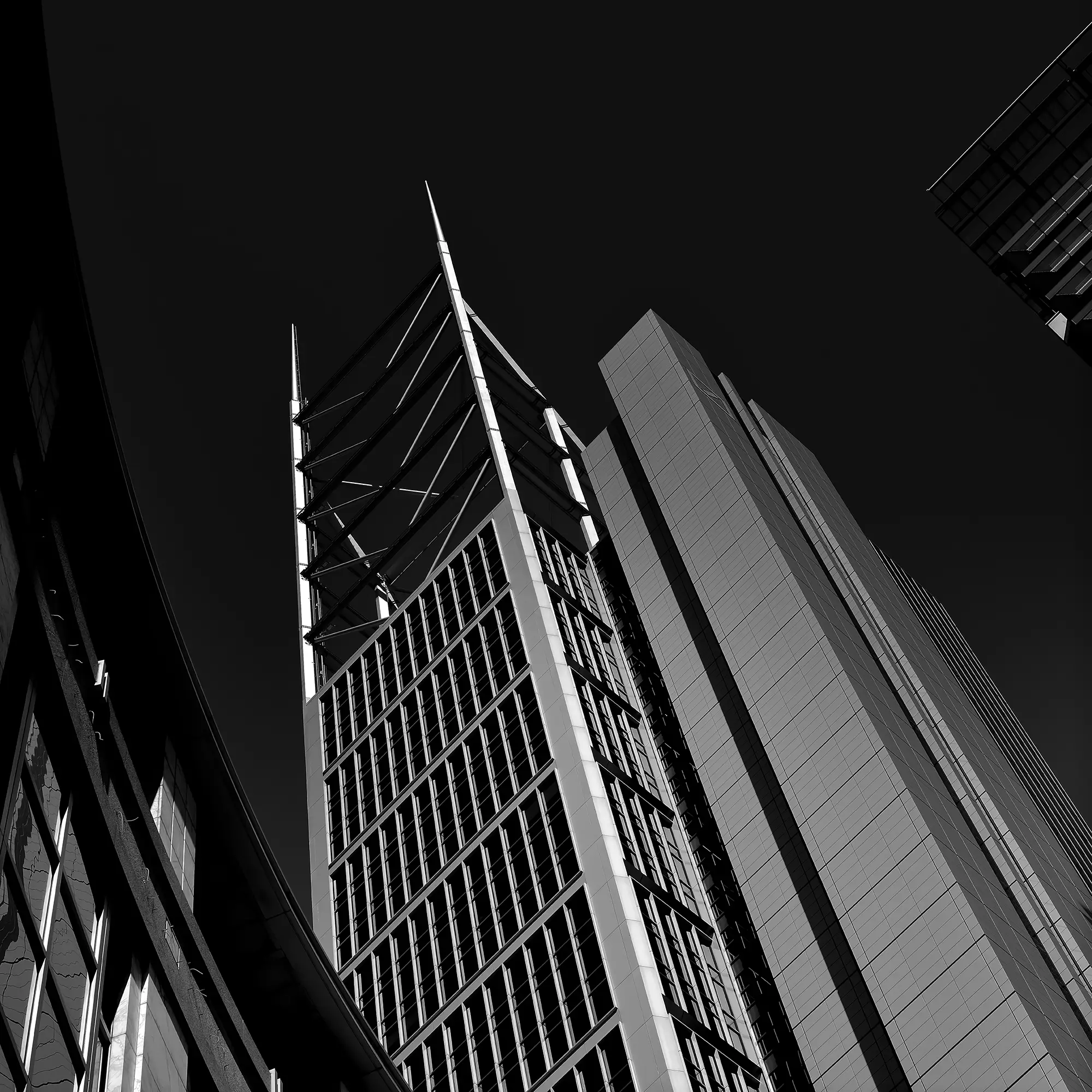BLACK & WHITE – INFRARED WALL ART
Exploring Black and White Infrared Cityscape Architecture Photography: A Blend of Urban Elegance and Otherworldly Atmosphere by Mark Zissis
Black-and-white photography has long been celebrated for its timeless elegance, allowing photographers to highlight form, light, and texture without the distraction of color. When you combine this monochromatic approach with infrared (IR) photography—an imaging technique that captures light invisible to the human eye—a unique genre emerges: black-and-white infrared cityscape architecture photography, This niche form of photography creates an otherworldly experience by blending urban architecture with ethereal lighting effects, producing surreal and captivating images that redefine how we perceive modern cityscapes.
What is Infrared Photography?
Infrared photography uses special filters or modified cameras to capture wavelengths of light beyond the visible spectrum, typically between 700nm and 1200nm. Instead of registering light as we see it, infrared photography records infrared light reflected off surfaces. Materials like foliage, sky, and concrete react differently to infrared, offering an array of unexpected contrasts.
For example, green plants and trees reflect a significant amount of infrared light, causing them to appear bright or white in infrared images—an effect known as the “Wood Effect.” Urban materials like steel, glass, and asphalt absorb infrared light, often rendering these elements darker or more subdued in the final image. This contrast between natural elements and human-made structures is particularly striking in cityscape photography.
Why Black and White?
While infrared photography can also produce false-colour images, black-and-white infrared emphasizes the play of light, shadow, and texture. Removing color simplifies the image, placing the viewer’s focus squarely on architectural lines, shapes, and the dramatic interplay of light. It reveals the inherent geometry of city buildings, bridges, and urban infrastructure, transforming these structures into near-sculptural forms.
In cityscape architecture photography, where symmetry, patterns, and perspective are key, black-and-white infrared adds an extra layer of abstraction. It exaggerates the structural elements, emphasizing hard lines and intricate details while simultaneously softening skies and water reflections. This juxtaposition creates a sense of harmony between the organic and inorganic, merging the artificial world with a natural light effect that feels dreamlike.

The Surreal Transformation of Urban Environments
Infrared photography’s ability to capture light differently transforms even the most familiar cityscapes into unfamiliar, almost alien environments. Skies become dark, and clouds pop with stark contrast as if they were painted on the sky. The reflective surfaces of skyscrapers and glass buildings turn into moody, enigmatic shapes against glowing trees and whitewashed foliage, creating a dystopian or utopian feel depending on the composition.
For instance, capturing the towering skyline of a city like Sdyney City in infrared brings out dramatic contrasts between sleek, dark skyscrapers and glowing street-level greenery. The heightened visual differences provide a haunting quality, making a bustling metropolis seem strangely calm and quiet—otherworldly yet recognizable.
Techniques for Mastering Infrared Cityscape Architecture Photography
1. Use of Equipment: To shoot infrared images, photographers need either an infrared filter or a camera modified to capture IR light. While filters are a more affordable option, they require longer exposures, so using a tripod becomes essential. Modifying a camera for full-spectrum or dedicated infrared use allows for more creative flexibility, enabling handheld shooting with shorter exposure times.
2. Framing and Composition: Cityscape architecture photography is all about capturing grand, sweeping scenes. Infrared works particularly well with wide-angle lenses, which help frame vast urban expanses, drawing the viewer into the scale of the city. Look for compositions where the dark, reflective structures contrast with bright foliage, water reflections, or sky elements. Leading lines, symmetry, and patterns become even more visually impactful in infrared black and white, giving the image a structured yet surreal quality.
3. Post-Processing: Infrared photography often requires extensive post-processing. After capturing the image, converting it to black and white and adjusting the contrast and highlights helps bring out the dramatic tones that define infrared work. It’s important to play with shadow and highlight details to get the desired balance between dark buildings and glowing, ethereal skies. Texture is also crucial—accentuating architectural details without overwhelming the surreal light effects.
4. Timing and Lighting: Infrared photography is highly dependent on the time of day and weather conditions. Shooting under bright sunlight enhances the infrared effect, particularly when there’s a mix of natural and artificial elements, like trees, water, and steel. Cloudy or overcast days reduce infrared reflections, which can also provide a more subdued and eerie look, perfect for dystopian cityscapes.
Conclusion
Black and white infrared cityscape architecture photography is a unique intersection of artistic vision and technical prowess. By removing color and focusing on light and form, photographers create a surreal and abstract portrayal of urban environments. The stark contrasts and otherworldly atmosphere offer a fresh way of seeing cities, highlighting the intricate beauty of both nature and human-made structures. Whether you’re a seasoned photographer or someone looking to explore the possibilities of infrared, this genre offers a playground for creativity, transforming everyday cityscapes into extraordinary works of art.
For more information and to browse our selection, visit Mark Zissis. Transform your space with the timeless beauty of Black & White wall art and let your walls tell the stories of the City you love.
By incorporating Australian wall art into your decor, you can create a space that is not only visually appealing but also rich with meaning and inspiration. Whether you’re looking to make a bold statement or add a subtle touch of elegance, Australian wall art from Mark Zissis can help you achieve your design goals.


